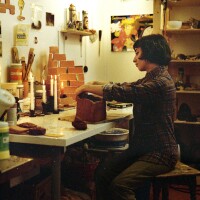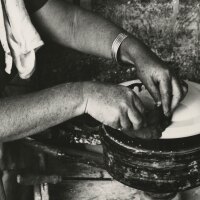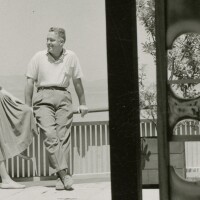De-skilled Ceramics: The Approachable Art Form

The Slow Time series looks at artists who choose to take the long way around, to meaningfully make their techniques needlessly hard on themselves, eschewing shortcuts and redefining the term "process-based." These artists practice radical patience in their creative output and thereby infuse their art with inherent meaning in its form beyond the aspect of aesthetic content.
Clay is a material which is nearly synonymous with the broader slow culture movement that inspired this series; perhaps no other single art-world substance is more evocative of dirty, hands-on, alchemical, allegorical, old-world art and craft. Even so, what people typically mean when they think of ceramics still tends toward that refined, high Heath style, where everything is fine and poised, or Edmund de Waal where it’s delicate, adamantly purist, psychological more than emotional and oh-so conceptual.
In powerful contrast to that heritage, rises the epic and still-expanding trend of “de-skilled” ceramics, an aesthetic and technical continuum of style which prizes a litany of effects and qualities that were once thought of as errors. Crackling, bubbling glazes, exposed raw clay, unevenly fired vessels, distresses and punctures, visible seams and scars, gestural, variable color, thumbprints, collapsed walls, tilting arcs. It’s easy to see why the metaphorical potential of this approach to clay, a material so often poetically associated with the body, would appeal to audiences craving the discernible presence of a person in time, in a resistance to machined perfection, mass production and digital flatness. Part of the appeal to enthusiastic audiences is the dramatic quality achieved by the reckless use of unpredictable, experimental or outsider techniques; while at the same time, many will argue that a convincing quality of organic roughness, distress, decay and fragility is achieved through twists in technique which is in fact very difficult to achieve.
“Ceramics are the yoga of the art world,” laughs Robert Miller. “Clay is its Earth Mother. Everybody is discovering ceramics. It’s wonderful and exciting, but they all end up needing help because it’s harder than it looks!”
For today's story, we corresponded with artists Enrique Martinez Celaya, Angel Chen, Galia Linn, Seth Kaufman, Robert Miller, Brian Rochefort, and Cathy Akers. While only some of them identify clay as their main medium, all of them work with it in thoughtful ways outside the box of conventional respectability. Here is an array of both trained and novice ceramicists who all share a terrestrial materialism, in which the physical and metaphysical qualities of the medium itself are an important part of the narrative of working with it. More than ever, a new art generation is studying ceramics, even as a wave of artists of all ages are compelled toward clay in headlong, largely self-taught investigations and experiments. They can't seem to help themselves. This is both refreshing to audiences, and irritating to genre traditionalists. It is perhaps best understood more broadly as a humanist instinct.
“Ceramics are the yoga of the art world,” laughs Robert Miller. “Clay is its Earth Mother. Everybody is discovering ceramics. It’s wonderful and exciting, but they all end up needing help because it’s harder than it looks!” Miller is an expert ceramicist with a pioneering mastery of monumentally scaled wheel-thrown vessels, as well as a popular tenured professor teaching the medium from its basic foundations to its soaring avant-garde. “Peter Voulkos, who really created this movement, he was the most skilled artist you can imagine. But yes, there is something about getting your hands dirty, people just respond to it. It's Zen and meditative, and it can be very, very frustrating. But you know, there’s a difference between looking raw and rough and chaotic and actually being those things.” The presence of obvious technical flaws opens up questions of intentionality on the part of the artist, namely the degree to which they either willfully embrace or serve at the mercy of the material challenges. “It’s hard to make it funky!” Miller says. “Critics go crazy over it, but I think that’s partly because they’ve never seen it before. Which is largely because the history of ceramics isn’t taught, and neither are the technical fundamentals. But that’s getting better.” Miller posits the situation is akin to fusion jazz, in that you can’t really solo improv without first learning how to really play the instrument.
Brian Rochefort makes ceramic objects, especially an exuberant world of magnificent "cups" that exert a hypnotic hold and veil their secrets. Looking for all the world like an explosion of chromatic skins, with rivers of kaleidoscopic lava, bubbles and gyres and minerals in profusion, his surfaces replicate the chaos of organic entropy But as Miller hinted at above, it takes a lot of technical mastery to let go and transcend technique. “ I consider myself a mixed-media artist working primarily in ceramics. I have always thought of ceramics as a material of potential,” he says. “I like to push clay and glaze as far as possible until my sculptures crack and fall apart. Controlling the material, combined with chance and accident is an exciting balance that keeps me interested. I don't believe there is much of a connection between my work and traditional techniques. I have always been interested in the vessel which can be considered traditional, but my work is constantly moving in different directions. I layer glazes to the max, which might appear sloppy or accidental to an untrained eye but it is skill and experience that gives these results.”

Among the most acclaimed artists working in the modern naive aesthetic and with advanced technical prowess is Matt Wedel, familiar to LA audiences through a series of triumphant exhibitions at LA Louver Gallery. Wedel’s often large-scale figures, animals and flowering succulents feature clunky planes, gestural, stylized contours and riots of color. His art historical and craftsmanship interests were formed in his upbringing, education and travels, and his thoughtful rebellions are both quirky and regal as he embraces and eschews, learns and unlearns, charms and innovates. In comments made to Art Ltd. for a profile a few years ago, Wedel offered a context for this moment in clay. “It’s a fad,” he said, “but also I imagine artists feeling like they can go there materially, because it’s still mostly unfamiliar, being just at the beginning of a new phase of acceptance as a legitimate fine art material. It was exposed in the 1960s, particularly in LA, but has remained insulated as a specific community — small, tight, isolated.” And now, there’s this explosive proliferation of styles and approaches. “Ken Price,” Wedel continued, “succeeded in being viewed in the context of sculpture generally, not just of ceramics. Richard Deacon has his made for him, so it’s not about the hands-on thing for him, it’s more conceptual. Urs Fischer embraces the accessibility and populism of the raw material, in a way utilizing the baggage of ‘lowness’ and broadening the context for looking at clay. There really is no longer just one way.”
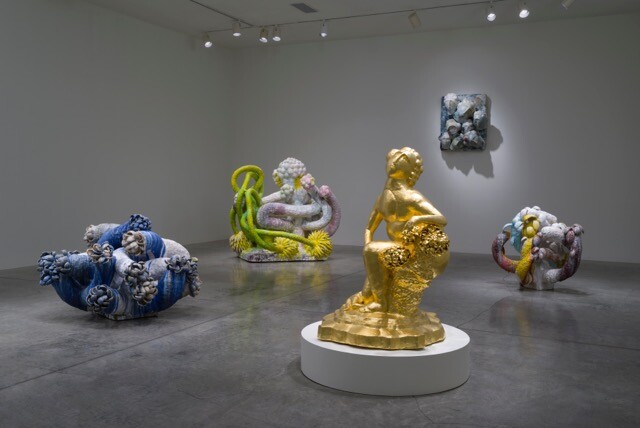
Speaking of Urs Fischer, one of the most dramatic and unforgettable elements of the Swiss artist’s 2013 exhibition at the Geffen Contemporary at MOCA, was when he invited some 1,500 people to come to the space and collaboratively work on a field of figures and animals in unfired clay. These came to surround his pieces, in what the curators evocatively called "a landscape of fragmented figures, ruins, and fracture." While not privileging technical mastery, to say the least, the undertaking did highlight the broad appeal, performative spectacle and unexpected properties of the star material. As it slowly dried and decayed over the course of the show, its mineral-infused organic aroma permeated the atmosphere.

While Enrique Martinez Celaya is best known as an ambitious painter and a sculptor of bronze at intimate and monumental scale, often the original sculpture is made in components of clay by his own hands on its way to the foundry; and every so often a piece will remain executed in ceramic to its final form, for example, the iconic German shepherd for his recent exhibition atSITE Santa Fe. Asked what he loves most about clay, EMC replies, "When it is my hands I am reminded of playing with mud as a kid, and I like that physical memory. I started using clay as a teenager. I appreciate how it moves and the life it has independent of my own wishes. I know how to model," he says, "how to shape. And I have a sense of what I want to see, but I don't know clay techniques — which is precisely why I use it. My friends at the Anderson Ranch have shown me a few things when I use clay for a project, but I remain a beginner at best. I use it when I want to connect what I am doing to the tradition of clay, particularly in its relation to craft.”
Like Martinez Celaya, Joshua Tree-based interdisciplinary artist Angel Chen’s passion for ceramics exists in tandem with an extensive painting practice. For her, it all sits on a clear continuum directed by expressive potential. Despite years of academic study (UCLA, CalArts, Skowhegan, Atlantic Center for the Arts), Chen has no formal training with clay. "Clay was a secret," she says. "No one took it seriously, and so it became a playground for freedom, primal Id instinct allowed a private arena. I do not seek to make a pot, nor a vessel, and cringe when I hear it called pottery. It is clay sculpture; you cannot put flowers in it. The way the material transforms from clay to bisque to fired ceramic is an alchemical quartz inversion. Perhaps that is the most intriguing part of all, when something malleable and vulnerable becomes impervious and forever. Temporal art scares me; I feel comfortable with forever."
“I loved painting for as long as I can remember,” she continues. “Possibly since birth. One day I discovered clay, but it is not new, it is ancient. So ancient and traditional, that the challenge is to make it modern. There is a spectrum of Brutalist macho physical clay and on the other side, delicate, ornate decorative porcelain. How about exquisite and muscular?” Chen’s desire for blending a new language of ancient and modern manifested, and ushered into creation Femme Brut, the style of her own invention with which she is increasingly associated. “Clay requires technical skills, drying time, attention to craft and understanding of the kiln firing to 2300 degrees. What do I love about it? The feel of it, the silky touch of fine porcelain, the sandy roughness of soldate, the lowly humble position of earthenware. Making something that lasts forever is a tall responsibility; ancient Chinese and Etruscan ceramics have survived centuries. After years identifying as a painter, I now see that painting is the ultimate illusion, creating depth and shadow and content that does not exist, it is merely colored liquid, and that is its charm, it is a depiction of something else. Sculpture stands its ground, it takes up space and requires the viewer to face it. Sculpture is in your space and must be taken into account. Femme Brut is dualistic in nature, both refined and primal. Clawing at the raw block of clay with a woman’s touch, a modern woman’s voice, sultry, graceful, and wild. Balancing Eastern and Western influences, delicate and forceful, mutable and eternal, timeless and now, elegant, and raw.”
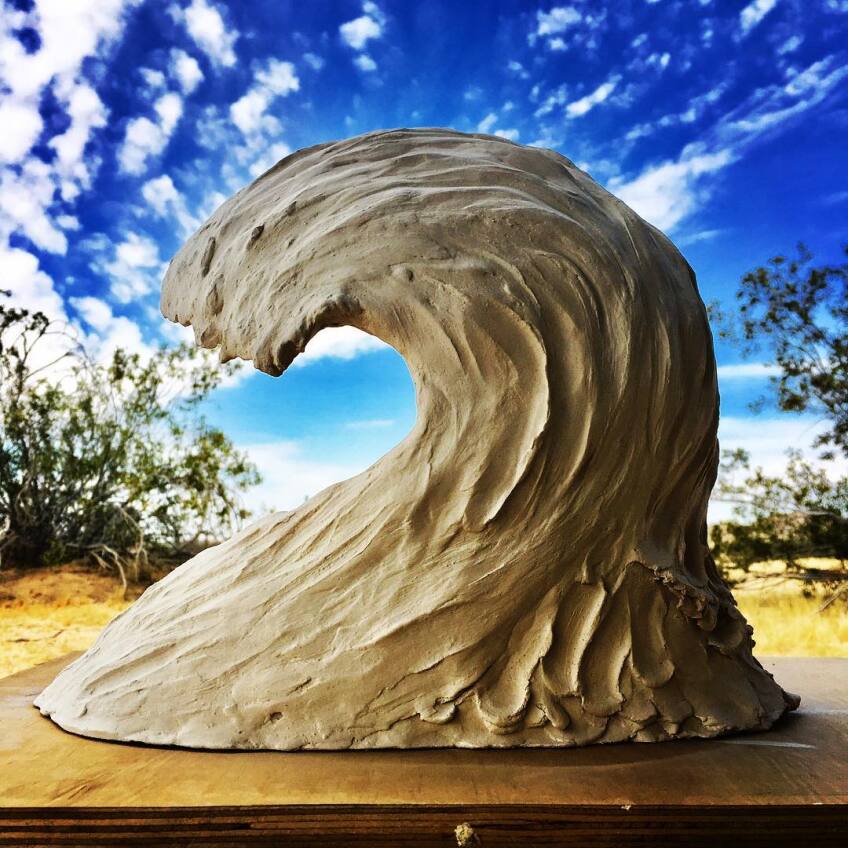
Galia Linn repeats the question back to me. “What do I love most about clay? The smell,” she says, “definitely the smell. Also, how physically exhausted working with large-scale bodies of clay makes me feel. My love/disdain relationship with clay began when I was 18 years old. Years later, in LA, when I was finding my way back to making art, I enrolled in a clay-shop by my house and spent three years learning how to throw. Just like working with architecture, I found the process to be mechanical, detached. But mostly I could not get to the scale I was envisioning. So I went back to Otis for continuing education and learned to weld. For two years I worked on nothing but metal. Clay at the time was considered the work I was doing to get ready for the “real” work, a warm-up not to be taken seriously. Then a few things happened.” She saw Peter Voulkos’ work at the Pacific Standard Time initiative’s Clay’s Tectonic Shift at Scripps, and Sterling Ruby's ceramics at the de La Cruz Collection, and a collector who bought four of her so-called warm-up vessels installed them next to a Mark Grotjahn painting. She began to realize that clay is a material, like any other. “From then on,” she recalls, “the work became freer, larger and unencumbered with rules and regulations. All that I’ve learned over the years from architecture, hand-building, wheel-throwing, and welding come into play in my practice.” Her work draws heavily on the physical, political, and poetic metaphors of the flesh, its decaying majesty, it's crimson-soaked skin, its susceptibility to violence. ‘These mixes of influences and techniques are not used linearly or literally,' she says. "They rather feed the intuitive body. I create places of ritual inhabited by clay relics. I use low-fire clay and glaze in high-fire temperatures to get bubbles and cracks. I tack weld large slabs of clay to connect them, soak clay with water, and more. But mostly I surrender to the clay, to its memory, and let it guide me through the process of rearranging dirt. Clay is the beginning and the end. It informs other materials and other materials inform it. It is essential to my life."

An inventor of absolutely original, crushed and scraped, funny and eccentrically nostalgic photo-clay hybrid sculptural objects, what Cathy Akers loves most about clay is how “intuitively” she can work with it, how at liberty she is to do as she pleases. "I feel free to explore and play with clay in a way that is difficult for me in other media, perhaps because I've never received formal instruction in clay," she observes. "I often have too many expectations and/or preconceived notions of how, for example, my drawings should look -- perhaps as a result of many years of formal training. But also, I think the nature of clay itself invites play. It's so plastic and tactile, so able to take any shape or form. Making objects with clay feels like a very direct, almost primal, form of expression -- there's such a direct relationship between the creator and the material. I like how simple and down-and-dirty the process is…My objects are designed to be roughly-made. I do not have any interest in ceramic techniques that aspire to produce perfect objects, such as throwing on the wheel." Akers has been working most often with clay for the past three years, although she doesn’t think of it as her main medium. “In the past ten years,” she says “I have stopped thinking about any medium as primary for me. I am especially happy when I able to combine two media in one piece, such as using photographic image transfers, as it creates interesting conversations between the photographs and the ceramic objects.”

Seth Kaufman isn't interested in perfection either. He is a conceptualist who experiments with ways to subvert and redefine conventional categories and basic genres like painting, sculpture, and photography. When it comes to his work in ceramics, he too is captivated by its transformational potential -- and he too is driven to distraction by love/hate of its mischief. He likes to make ceramic sculptures by literal breaking existing works of cynical kitsch, totems from various memorabilia worlds like museum shops, thrift stores and roadside stands and then reconstituting the crumble into post-cubist versions of David, the Virgin Mary, dogs, horses, French queens, and the baby Jesus. "I love that you can change the property of a material from one state to another, from viscous to solid," he says. "There are few other materials with the capacity to undergo this kind of transformation. There are also few other materials as cumbersome to work with, before they transform. Gravity is the collaborative force, and learning what the thresholds of the material are can consume a lifetime of study and practice. There are thousands of ceramic architectural forms in the world that are, in my opinion, among the most beautiful objects ever created. From toilets to storage urns, masterful ceramic forms abound! But perhaps the most compelling, for me, comes from the Mimbres Indians of North America who built and decorated small bowls which would be buried with their dead. The bowls would be turned upside down over the face of the deceased but not before a hole was broken into the bottom, to release not only the spirit of the bowl but of the deceased themselves, a practice called ‘killing the bowl.' I love formally successful functional and decorative ceramic constructions, but I also enjoy the idea of killing the functionality, the architectural integrity, and the decorative boastfulness. Kristen Morgin’s improbable unfired monster-pieces of America’s flawed prowess; Andy Goldsworthy packing wet clay onto walls or boulders, allowing the hyper-view of entropy. As a viewer, I appreciate and revere the materials, the processes and the accomplishments of ceramic practitioners. As a sculptor and ceramic novice, I beg for respectful irreverence.”
Follow these artists on Instagram
Matt Wedel
Enrique Martinez Celaya
Angel Chen
Seth Kaufman
Cathy Akers
Galia Linn
Top Image: "Rituals of Sphinx and Lamassu" 2013 exhibition by Galia Linn and Elena Stonaker at MaRS Gallery | Shana Nys Dambrot
